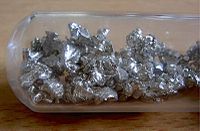Calcium
Calcium is the chemical element with the symbol Ca and atomic number 20. Calcium is essential for living organisms, in particular in cell physiology, where calcium ions Ca2+ regulate cellular processes. As a major material used in mineralization of bones and shells, calcium is the most abundant metal by mass in many animals.
Calcium as nutrient for plants
Calcium carbonate is a chemical compound with the formula CaCO3. It is a common substance found in rocks in all parts of the world, and is the main component of shells of marine organisms, snails, coal balls, pearls, and eggshells. Calcium carbonate is the active ingredient in agricultural lime, and is usually the principal cause of hard water.[1]
Liming is the application of calcium- and magnesium-rich materials to soil in various forms, including marl, chalk, limestone, or hydrated lime. This neutralises soil acidity and increases activity of soil bacteria.[2]
Agricultural ime is used to increase the pH of soils.
Calcium as nutrient in food
Calcium is important for building strong bones and teeth. Almost all of the calcium we use in our bodies is for building strong bones. It is also involved in normal blood clotting, muscle and nerve function, lowering blood pressure and is thought to prevent colon cancer.
If we do not get enough calcium every day from the foods we eat, it is taken out of our bones. After many years of not getting enough calcium, our bones become very weak and brittle. Osteoporosis is the name of this disease. It can cause bones to break very easily and the jaw bone to shrink so teeth are lost. It can lead to curvature of the spine.
Symptoms of deficiency are: Muscle weakness, spasms and cramp, softening of the bones, which could lead to osteoporosis, back pain, brittle bones and fractures.
Older women are especially at risk for osteoporosis. By getting enough calcium from the food we eat all through our life, we can make sure our bones and teeth stay healthy. One of the best sources of calcium is milk, and foods made from milk, like yogurt and cheese. Leafy green vegetables, tofu, sesam seeds, almonds and canned fish with bones are also good sources. Other foods, such as some brands of orange juice, have added calcium.[3]
See also
References
External links
- Calcium Wikipedia
- Calcium carbonate Wikipedia

